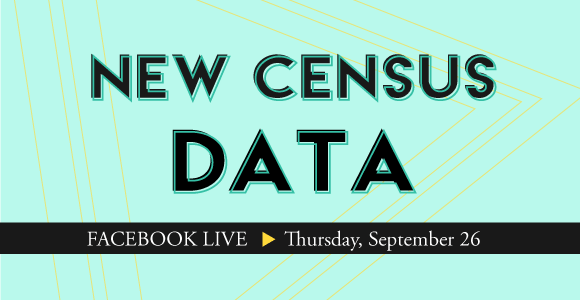This week, the U.S. Census Bureau released data from the 2018 American Community Survey (ACS). The American Community Survey estimates are released annually and allow us to track how Texans fare in areas like income, poverty, education, and healthcare. Census data is an invaluable source for helping us measure progress toward achieving a Texas where everyone is healthy, well-educated, and financially secure.
Here is our FacebookLive video and some of the highlights from the 2018 data:
The median household income in Texas in 2018 was $60,629, meaning that half of Texas households had income above $60,629, and half had income below. Factoring in inflation, median incomes were stagnant in 2018 compared to 2017 ($60,649) with no significant change. Income stagnation could be a worrisome indicator for Texans, especially because not all families across the state have benefited from economic growth equally in recent years.
A large wage gap persists for women among full time, year-round Texas workers, with the median male worker taking home over $9,800 more than the median female worker. That gap is even larger for households of color. White households had a median income of $74,509, as compared to only $45,545 for Black and $48,175 for Hispanic households, with Asian households leading at $87,120 – showing that not all Texans are sharing equally in our state’s economic prosperity.
Our state’s poverty rate increased from 2017, up to 14.9% percent compared to 14.7%, after years of improvement. This was a significant increase of roughly 104,000 people living in poverty, as the state population swelled from 27.7 to 28.1 million. Our poverty rate remains higher than the national poverty rate, with 4.2 million Texans living below the official poverty threshold in 2018 ($25,465 for a family of four). While the official poverty threshold is used to determine eligibility for government services, many advocates believe this estimate is too low to realistically reflect families’ needs. (Learn more.)
One in every five Texas children lives in poverty—that’s over 1.5 million kids—and children of color are disproportionately likely to live below the poverty line. The 2018 child poverty rates show that Hispanic and Black children are three times more likely to live in family poverty in Texas than White children. Children growing up in poverty are more likely to face challenges like housing and food insecurity, which can affect their ability to learn in school.
Living in neighborhoods with high concentrations of poverty (rates of 30 percent or more by census tract) can also have a negative impact on children. States like ours in the South and West tend to have the highest rates of children living in concentrated poverty, according to a new report released by the Annie E. Casey Foundation this week: “Children Living in High-Poverty, Low-Opportunity Neighborhoods.” Half of the Latino children living in concentrated poverty in America are in just two states: California and Texas. While Texas saw a 21% decrease in the rate of children living in concentrated poverty from 2013-2017 (as compared to 2008-2012), over one million remain in high-poverty neighborhoods that lack high-quality schools, accessible job opportunities, reliable transportation, and safe places for recreation.
Texas also has the worst health coverage rate for children in the nation, with over 870,000 Texas children without health insurance; that’s 11.2% of Texas children uninsured compared to 5.5% nationally (and worse by a large margin than the second-worst state: Alaska at 9.4%). Texans of all ages also fared poorly on health insurance coverage at 17.7%, again the highest in the nation. For more on health insurance numbers, see our Health & Wellness team’s breakdown. If you are interested in mobilizing around efforts to improve Texas’s dire uninsured rate, check out your local Sick of it TX campaign!
Several Texas cities also stood out this year — with San Antonio topping the list for the highest percentage of people living in poverty among the nation’s most populous metropolitan areas, and Houston having the highest uninsured rate while workers experience stagnant wages. Also of concern, Texas is one of only nine states that saw a rise in income inequality in 2018.
The information contained in the 2018 ACS data release underscores how critical the 2020 Census will be. As the once-a-decade count of all people living in the United States, the 2020 Census will determine things like our representation in Congress and the distribution of federal funding. This includes funding for programs critical for the well-being of our residents such as Medicaid, Pell Grants, and the Supplemental Nutrition Assistance Program (SNAP, formerly “food stamps”). For more information on why the 2020 Census matters and how Texans can help get out the count, check out our resources here.
This week’s American Community Survey data release follows the release of the most recent Current Population Survey (CPS). To better understand how the ACS and CPS are different, check out our side-by-side comparison guide.
CPPP’s Research and Planning Intern Cindy Ji contributed to this report. For more information or to schedule an interview with one of our CPPP experts, please contact Communications Director Oliver Bernstein at bernstein@cppp.org.
